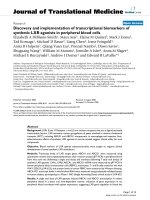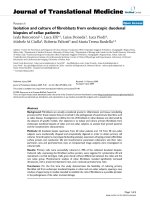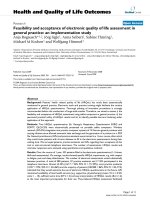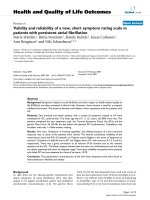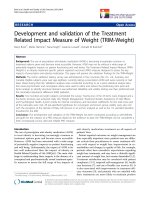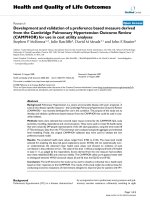báo cáo hóa học: " Complications and management of acute copper sulphate poisoning; A case discussion" pot
Bạn đang xem bản rút gọn của tài liệu. Xem và tải ngay bản đầy đủ của tài liệu tại đây (186.34 KB, 17 trang )
This Provisional PDF corresponds to the article as it appeared upon acceptance. Fully formatted
PDF and full text (HTML) versions will be made available soon.
Complications and management of acute copper sulphate poisoning; A case
discussion
Journal of Occupational Medicine and Toxicology 2011, 6:34 doi:10.1186/1745-6673-6-34
Champika SSK Gamakaranage ()
Chaturaka Rodrigo ()
Sajitha Weerasinghe ()
Ariaranee Gnanathasan ()
Visvalingam Puvanaraj ()
Harshani Fernando ()
ISSN 1745-6673
Article type Case report
Submission date 8 November 2011
Acceptance date 19 December 2011
Publication date 19 December 2011
Article URL />This peer-reviewed article was published immediately upon acceptance. It can be downloaded,
printed and distributed freely for any purposes (see copyright notice below).
Articles in JOMT are listed in PubMed and archived at PubMed Central.
For information about publishing your research in JOMT or any BioMed Central journal, go to
/>For information about other BioMed Central publications go to
/>Journal of Occupational
Medicine and Toxicology
© 2011 Gamakaranage et al. ; licensee BioMed Central Ltd.
This is an open access article distributed under the terms of the Creative Commons Attribution License ( />which permits unrestricted use, distribution, and reproduction in any medium, provided the original work is properly cited.
Complications and management of acute copper sulphate poisoning; A case
discussion
1
Champika SSK Gamakaranage,
2
Chaturaka Rodrigo,
3
Sajitha Weerasinghe,
2
Ariaranee
Gnanathasan,
4
Visvalingam Puvanaraj and
3
Harshani Fernando
Affiliations:
1
University Medical Unit, National Hospital of Sri Lanka, Colombo, Sri Lanka
2
Department of Clinical Medicine, Faculty of Medicine, University of Colombo, Sri Lanka
3
Ward 49, National Hospital of Sri Lanka, Colombo, Sri Lanka
4
Medical Intensive Care Unit, National Hospital of Sri Lanka, Colombo, Sri Lanka
Corresponding author:
Chaturaka Rodrigo
Registrar in Internal Medicine
University Medical Unit
National Hospital of Sri Lanka
Colombo 10, Sri Lanka
Tel: +94 71 8130991
Fax: +94 112 689188, Email:
Email addresses:
CSSKG:
CR:
SW:
AG:
VP:
HF:
Abstract
Copper sulphate ingestion (accidental or deliberate) is a rare form of poisoning usually limited to the
Indian subcontinent. Though the rates are on the decline, it is essential that physicians are aware of its
lethal complications and management strategies. The main complications of copper sulphate ingestion
include intravascular haemolysis, methaemoglobinaemia, acute kidney injury and rhabdomyolysis. The
lethal dose can be as small as 10 grams. We have explored the complications of acute copper sulphate
poisoning with examples from two case presentations. We also recommend measures for prevention of
such events.
Introduction
Copper sulphate is an easily accessible chemical in Sri Lanka that is sold over the counter. It is commonly
used as a pesticide, in leather industry and also in making home-made glue. Burning of copper sulphate
in houses and shops (as a good luck charm and for religious activities) is a common practice among
Buddhists and Hindus. The marine blue colour of the hydrated form of copper sulphate crystals is
attractive to children and is a reason for inadvertent poisoning. However, many admissions due to
copper sulphate poisoning in adult medicine are acts of deliberate self harm. Ingestion of significant
quantities of copper carries a risk of multi organ failure and death[1]. Unfortunately, many physicians
are not familiar with the complications and management of this unusual form of poisoning that has
become a rarity. We share our experience in treating two such patients and discuss the clinical
manifestations, management issues and suggestions for prevention.
Case presentation 1
A 26 year old male was admitted following ingestion of approximately 30 grams of copper sulphate 48
hours prior to admission. He had been managed initially at the local hospital for 2 days, with
penicillamine (500mg 6 hourly) and symptomatic treatment. On admission, he complained of epigastric
and right hypochondrial pain, vomiting, haematemesis and melaena. There were no other bleeding
manifestations. His urine output had reduced and was noted to be dark in colour. He did not complain
of shortness of breath at rest or on exertion.
On examination, he was febrile, pale, icteric and cyanosed (chocolate cyanosis). Pulse rate was 80/min
and blood pressure was 120/80mmHg. Examination of the precordium and the respiratory system were
unremarkable. Epigastric and right hypochondrial regions were tender with a firm and tender liver that
was palpable 2cm below costal margin. The epigastric pain was severe and radiated to back. Other
organs were not palpable. He was conscious, rational and the neurological examination was normal.
During the hospital stay, he developed several complications of copper sulphate poisoning, namely;
haemolysis, acute kidney injury, erosive gastritis with upper gastrointestinal bleeding,
methaemoglobinaemia and hepatitis. The investigation results are summarized in table 1.
Within the first four days since admission, he became anuric and oedematous. Pleural effusions and
mild ascites were noted on ultrasonography which also showed evidence of acute renal parenchymal
disease. The serum creatinine levels progressively increased with concurrent hyperkalaemia. He had to
be supported with haemodialysis for nearly 4 weeks (started at day 4 since admission) until his renal
functions recovered.
There was a significant drop in haemoglobin level which would have been contributed by the copper
induced haemolysis (increased total bilirubin and indirect bilirubin fraction, evidence from blood picture,
increased reticulocyte index) and upper gastrointestinal bleeding due to erosive gastropathy (confirmed
later with upper GI endoscopy). He was transfused with 3 units of red cell concentrates to maintain the
haemoglobin level above 11 g/l. An intravenous omeprazole infusion was continued for 4 days.
The methaemoglobinaemia could not be confirmed by biochemically as the assay was unavailable at the
hospital. It was diagnosed clinically based on the presence of chocolate coloured cyanosis and a
peripheral saturation of 85% (with pulse oximetry) when the central saturation (as measured by arterial
blood gas) was 98%. The patient was treated with IV methylene blue 2mg/kg (in 5% dextrose) for the
methaemoglobinaemia. The cyanosis responded to the initial dose and further dosing was unnecessary.
The hepatitis was managed symptomatically and the liver enzyme levels were not markedly altered.
His abdominal pain and clinical features resembled acute pancreatitis (epigastric pain radiating to back,
lack of hard abdominal signs despite severe pain) and interestingly the serum amylase level was also
very high. He was treated as for acute pancreatitis and the serum amylase level returned to baseline as
the overall condition improved.
Chelation therapy was started with penicillamine at a dose of 500 mg 6 hourly. The patient made a good
clinical recovery and was discharged on day 38 (D38) after admission. He had no further complaints and
his serum creatinine level was within reference range in a follow up visit 2 weeks later.
Case presentation 2
A 45 year old, previously healthy man was admitted two hours after ingestion of approximately 50
grams of highly concentrated copper sulphate, in a suicidal attempt. Immediately after ingestion, he had
vomited bluish gastric contents and later complained of body weakness and abdominal pain.
On examination, he was conscious, rational, hemodynamically stable with a pulse rate of 80 beats per
minute and a blood pressure of 120/80mmHg. The respiratory, abdominal and nervous system
examination was unremarkable.
His investigation results are summarized in table 2.
The patient developed severe epigastric pain with loose stools and melaena within 48 hours since
admission. The haemoglobin dropped to 6.3g/l with evidence of intravascular haemolysis. By day 4 he
developed severe aspiration pneumonia and had to be electively intubated and ventilated.
Haemodialysis was initiated from day 5 onwards due to concurrent acute kidney injury. Dialysis was
continued on an every other day basis for 10 days till the renal functions started recovering.
The patient was managed with supportive care and chelation therapy (oral penicillamine 500mg, 6
hourly). Erosive gastropathy was treated with an intravenous omeprazole infusion and low haemoglobin
was corrected with red cell concentrate transfusions. Aspiration pneumonia was treated with
intravenous meropenem 1g 8 hourly as per antibiotic sensitivity pattern. He required mechanical
ventilation for eight days in the intensive care unit and was subsequently transferred to the ward and
observed for further complications. The patient made a gradual convalescence and was discharged after
25 days of hospital stay. He did not develop any further complications on follow up
Discussion
Ingestion of more than 1g of copper sulphate results in manifestation of symptoms of toxicity[2].
However, this is only a rough threshold for toxicity and depends on individual factors. Mortality in cases
of severe poisoning is high and the lethal dose of ingested copper sulphate is between 10-20g[3].
The clinical manifestations of copper sulphate poisoning include; erosive gastropathy, intravascular
haemolysis, methaemoglobinaemia, hepatitis, acute kidney injury and rhabdomyolysis. Arrhythmias and
seizures are also reported probably secondary to other organ system involvement[1, 4].
Common gastrointestinal manifestations of copper poisoning are predominantly due to corrosive injury.
Haematemesis and melaena are observed with severe overdose probably due to bleeding from mucosal
injury. Liver gets damaged early in copper poisoning as the majority of absorbed copper is deposited in
liver after being delivered from the portal circulation. Acute liver failure following tissue necrosis can
occur due to direct copper toxicity [2, 5].
Two major haematological manifestations of copper sulphate poisoning are intravascular haemolysis
and methaemoglobinaemia[1]. Intravascular haemolysis can start as early as within the first 24 hours
since ingestion and is due to the direct oxidative damage to erythrocyte membranes. The haemolysis
can be rapid and severe with drastic drops in the haemoglobin level. The Cu
2+
ion oxidizes the Fe
2+
ion in
haemoglobin to Fe
3+
resulting in its conversion to methaemoglobin[2]. This manifests as cyanosis and
loss of oxygen carrying capacity of blood.
Acute kidney injury is a much commoner manifestation of toxicity with some case reports having an
incidence as high as 40-60% [6-9]. The possible mechanisms of kidney damage include; pre-renal failure
due to dehydration (vomiting, diarrhea, reduced fluid intake), haemoglobinuria, sepsis, rhabdomyolysis,
direct copper toxicity on proximal tubules and secondary effects of multi organ dysfunction. The
recovery of renal function following copper sulphate ingestion is observed to be slow and incomplete. In
the first patient it took nearly 5 weeks before he was independent of dialysis.
The severe epigastric pain (unusual for gastropathy alone) and elevated amylase level in the first patient
indicated the possibility of acute pancreatitis. It is not a recognized complication of copper sulphate
poisoning. However, a rise in serum amylase cannot be attributed to pancreatitis alone (even acute
kidney injury is associated with a rise in serum amylase) and we could not perform a CT scan with
intravenous contrast in the acute phase of illness due to the renal impairment. Therefore, in this patient,
pancreatitis could not be confirmed. This observation has also been reported by Gunay et al[10]
previously in a single patient of a case series. We suggest that serum amylase level should be monitored
carefully in patients with copper sulphate poisoning and the possibility of acute pancreatitis must be
considered though it may be difficult to confirm it by imaging due to concurrent renal failure.
The management of copper sulphate poisoning centers on four key principles; a) reducing absorption b)
close observation for complications c)supportive therapy and d) chelation therapy to remove active
copper from the body.
After ingestion, the contact damage to mucosa can be minimized by drinking large quantities of milk and
water[1]. Dilution reduces the direct mucosal injury. Emesis must be avoided as repeated exposure of
the oesophagus to the corrosive agent may inflict further damage on the mucosa. Some authors
recommend the use of activated charcoal (50grams dissolved in 200ml of water, administered in
multiple doses if necessary at 6 hourly intervals) to reduce absorption, but it is of unproven benefit[1].
All complications mentioned above must be monitored for from the first 24 hours onwards (daily full
blood counts, serum electrolytes, liver and renal function tests). If the patient had vomited, aspiration
pneumonia or a chemical pneumonitis should be anticipated. It would be worthwhile to have a baseline
chest roentgenogram in this regard. Evidence for haemolysis must be looked for with daily blood
pictures and reticulocyte counts. If the patient is having spontaneous bleeding, the coagulation profile
should be requested and if he is cyanosed, methaemoglobin levels should be assessed.
Anaemia from haemolysis or bleeding must be corrected with transfusion with red cell concentrates.
Methaemoglobinaemia is treated with methylene blue (intravenous injection of 1-2 mg/kg/dose and
repeated if cyanosis persists beyond one hour)[11]. However, high doses of methylene blue itself can
cause haemolysis and it is contraindicated in G6PD deficiency. Alternatives to methylene blue in such
situations would be hyperbaric oxygen and ascorbic acid (a much weaker reducing agent)[11].
Renal failure must be recognized early by careful monitoring of serum creatinine and urine output.
Though dialysis is ineffective in clearing copper from the body, it will be an essential requirement to
sustain life in event of acute kidney injury[1]. Peritoneal dialysis is ineffective in maintaining the
relatively longer requirement for dialysis until the renal functions recover. However, it is an option when
haemodialysis facilities are not available.
Chelation therapy in copper sulphate poisoning aims at removing ingested copper from the body. The
efficacy of these chelating agents is unproven. Penicillamine is a commonly used chelating agent at a
dose of 1-1.5 g/d in 2-4 divided doses[1]. Both our patients received a high dose of oral penicillamine
without any ill effects. It must be used carefully in places without access to renal replacement therapy as
penicillamine is nephrotoxic. Intramuscular administration of dimercaprol or British anti-Lewisite (BAL)
(3-5mg/kg/dose with four hourly administration in first two days and tailed off over a total of 7-11 days)
is recommended when oral administration of penicillamine is difficult or contraindicated (severe
corrosive injury in alimentary tract)[12].Some authors question its efficacy when compared to
penicillamine. Edetate Calcium disodium is another option and some recommend it as the first line
therapy when the use of penicillamine is deemed unsafe [13]. There are case reports of patients with
copper poisoning being successfully treated with edetate calcium disodium followed up by either oral
penicillamine or dimercaprol[13, 14]. However, edetate calcium disodium also carries the risk of acute
tubular necrosis and have to be carefully administered with dose reductions in presence of acute kidney
injury[13]. The duration of chelation therapy is not established by evidence. It is recommended to treat
with chelators as long as the serum copper level remain above normal[13].
Despite being rare, intoxication with copper sulphate can be fatal. Therefore it is important to
concentrate on prevention of copper sulphate ingestion by measures such as;
1. stopping over the counter sale of copper sulphate and restriction of purchase, distribution and
sale to authorized agents only
2. alternately, over the counter availability of copper sulphate can be limited to large sized crystals;
cases of poisoning are usually by dissolving the fine power like pulverized form of the compound
Conclusions
Ingestion of copper sulphate is a rare form of poisoning. However, given the complications and high
mortality rates, it’s essential that clinicians are familiar with the management of such patients. The
effects of poisoning can have deleterious effects on the upper digestive tract, kidneys, liver and blood
(intravascular haemolysis, methaemoglobinaemia). We have observed that one of our patients had
typical clinical features of acute pancreatitis (not a recognized complication) with an elevated serum
amylase level. It may be worthwhile that physicians treating such patients assess the serum amylase
level during the acute illness. We further recommend that restricting the availability of the pulverized
powdered form of the compound in the open market might be an effective measure in preventing
deliberate self harm by ingestion of copper sulphate.
Consent
Written informed consent was obtained from the patients for publication of this case report. Copies of
the written consent are available for review by the Editor-in-Chief of this journal.
List of abbreviations
Abbreviations are explained where they are first used in text
Competing interests
The author(s) declare that they have no competing interests.
Authors' contributions
CR, CSSKG, AG have participated in designing, article search, information coding and writing of the
manuscript. They were also responsible for the clinical care of the first and second patients. VP, SW and
HF were responsible for the clinical care of the third patient. All authors have read and approved the
final manuscript.
Authors’ information
CR, SW and CSSKG (MBBS) are registrars in Internal Medicine attached to the National Hospital of Sri
Lanka. VP (MBBS) is Medical Officer of the medical intensive care unit of the National Hospital of Sri
Lanka. HF (MBBS, MD, FRCP, FCCP) is Consultant Physician of Ward 49, National Hospital of Sri Lanka.
AG (MBBS, MD, MPhil, FRCP) is Consultant Physician and Professor in Medicine attached to the
Department of Clinical Medicine, Faculty of Medicine, University of Colombo, Sri Lanka.
References
1. Saravu K, Jose J, Bhat MN, Jimmy B, Shastry B: Acute ingestion of copper sulphate: A review on
its clinical manifestations and management. Indian J Crit Care Med 2007, 11:74-80.
2. Sinkovic A, Strdin A, Svensek F: Severe acute copper sulphate poisoning: a case report. Arh Hig
Rada Toksikol 2008, 59:31-35.
3. Ellenhorn MJ (Ed.). Metals and Related Compounds, 2 edition. Maryland: Williams and Wilkins;
1997.
4. Fernando R: Management of poisoning. 3 edn. Colombo: National poisons information centre,
National Hospital of Sri Lanka; 2007.
5. Jantsch W, Kulig K, Rumack BH: Massive copper sulfate ingestion resulting in hepatotoxicity. J
Toxicol Clin Toxicol 1985, 22:585-588.
6. Dash SC: Copper sulphate poisoning and acute renal failure. Int J Artif Organs 1989, 12:610.
7. Agarwal SK, Tiwari SC, Dash SC: Spectrum of poisoning requiring haemodialysis in tertiary care
hospital in India. Int J Artif Organs 1993, 16:20-22.
8. Chugh KS, Sharma BK, Singhal PC, Das KC, Datta BN: Acute renal failure following copper
sulphate intoxication. Postgrad Med J 1977, 53:18-23.
9. Malik M, Mansur A: Copper Sulphate poisoning and exchange tranfusion. Saudi J Kidney Dis
Transpl 2011, 22:1240-1242.
10. Gunay N, Yildirim C, Karcioglu O, Gunay NE, Yilmaz M, Usalan C, Kose A, Togun I: A series of
patients in the emergency department diagnosed with copper poisoning: recognition equals
treatment. Tohoku J Exp Med 2006, 209:243-248.
11. Ellenhorn MJ (Ed.). Nitrates, Nitrites and methaemoglobinemia, 2 edition. Maryland: Williams
and Wilkins; 1997.
12. Nelson LS (Ed.). Copper, 7 edition. New York: McGraw-Hill; 2002.
13. Franchitto N, Gandia-Mailly P, Georges B, Galinier A, Telmon N, Ducasse JL, Rouge D: Acute
copper sulphate poisoning: a case report and literature review. Resuscitation 2008, 78:92-96.
14. Oldenquist G, Salem M: Parenteral copper sulfate poisoning causing acute renal failure.
Nephrol Dial Transplant 1999, 14:441-443.
Tables
Table 1: Summary of investigation results of the first patient from admission up to day 30 (D30)
Investigation (Reference range) D1 D4* D15 D20 D30
Haemoglobin (g/l) (13-16) 14.9 10.4 9.5 8.9 11.6
Platelets (x10
9
/l) (150-450) 337 268 138 254 276
White blood cells (x 10
9
/l) (4-11) 19 21.2 10.3 6.3 5.7
AST (U/L) (<40) 138 - 52 62 28
ALT (U/L) (<40) 27 - 10 10 10
ALP (U/L) (<360) - - 406 242 225
Total Bilirubin (ɥmol/l) (18-21) - - 42 21 18
Protein (g/L) (60-85) - - 67 56 63
Albumin (g/L) (36-48) - - 37 28 34
Globulin (g/L) (23-35) - - 30 28 29
Blood urea (mg/dl) (<40) 52 - - 137
Creatinine (ɥmol/l) (<120) 131 349 716 756 453
Na+(meq/l) (136-148) 137 140 135 142 145
K+ (meq/l) (3.5-5.3) 4.2 6.9 3.1 4.5 4.4
Cl- (meq/l) (95-105) 109 - - -
Fasting blood sugar (mg/dl) (65-
110)
132 - - -
Serum Amylase(U/l) (25-125) - 743 3975 2380 460
*Haemodialysis was started at D4
Table 2: Summary of investigation results of the third patient
Investigation D0 D2-5 On discharge
Haemoglobin (g/l) 14.1 6.9 12.6
White blood cells (x 10
9
/l) 9.9 40.6 (85% neutrophils) 9.6
Serum Creatinine (μmol/l) 61 256 - 621 136
AST (U/l) - 1077 76
ALT (U/l) - 257 42
Total bilirubin (μmol/l) - 265 32
Direct bilirubin (μmol/l) (<4) - 124 18
PT/INR - 2.2 1.1
C-reactive protein (CRP)
(<5mg/l)
7.3 5
Reticulocyte count (0.25-2.5%) 9%
